Khabar Magazine. July 2023 print.
Seeing the Great Barrier Reef was on my bucket list for a long time. But for someone who is not a confident swimmer, it seemed out-of-bounds for me. So, earlier this year, I enrolled in personal adult swim lessons at my athletic club in Marietta. While dreaming of my upcoming trip to Australia, I learned new strokes and underwater breathing techniques. Even though those lessons were not enough to get me my diving certification, they were enough to help me become comfortable swimming and snorkeling in the open ocean without any nerves.
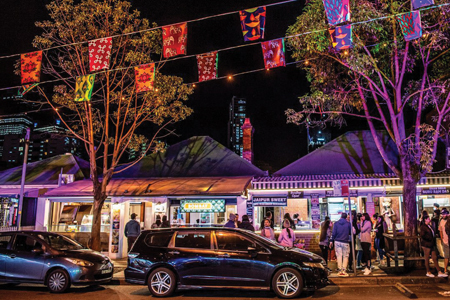
And the payoff was worth it! The fame of the Reef is not for nothing, I learned. Snorkeling there, I saw the most colorful and diverse underwater gardens I have seen in my life. All shapes, sizes, and colors of corals, giant clams, clownfish, scissor-tail sergeant, parrotfish, angelfish, lionfish, stingray, and even a few blue starfish were right under me. At one point, I was surrounded by green sea turtles who seemed oblivious to my presence.
Considering Australia is a vast land offering many such bucket list destinations that are almost impossible to cover in just one trip, it may help the first-time visitor to be selective in choosing an itinerary.
During my many visits, I learned about Australia’s rich biodiversity as well as its tormented history, its many struggles as well as the process of repatriation with the indigenous cultures, and its changing attitude towards immigration and inclusivity. I found that the Australian people are incredibly friendly, funloving, and fearless. They hardly ever complain and are always looking to find a solution to move forward in everyone’s best interest. Perfect planning, good infrastructure, and a positive attitude also make traveling through Australia very convenient whether you are going solo or in a group.
Here is my list of top five destinations down under.
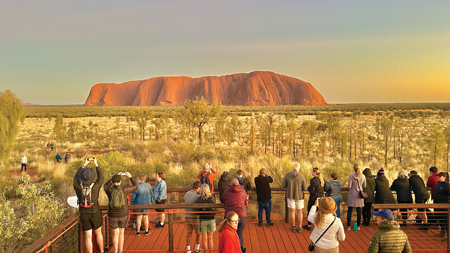
Sunrise at Uluru, the sacred site of the Anangu people, who are the oldest living culture known to man.
(Photo: Sucheta Rawal)
SYDNEY: A lovely blend of Los Angeles-meets-London
With modern skyscrapers hugging a pristine harbor, historic English architecture, and stunning attractions like the Sydney Harbour Bridge and Opera House, Sydney feels like a lovely blend of Los Angelesmeets- London.
One of the best spots to stay in Sydney is The Four Seasons Hotel in the CBD area, next to walkable art galleries in the Rocks District and lively shopping and dining at Circular Quay. Many of the rooms offer unobstructed views of the skyline—perfect for watching the New Year’s Eve fireworks and the annual Vivid Sydney festival (held in May-June).
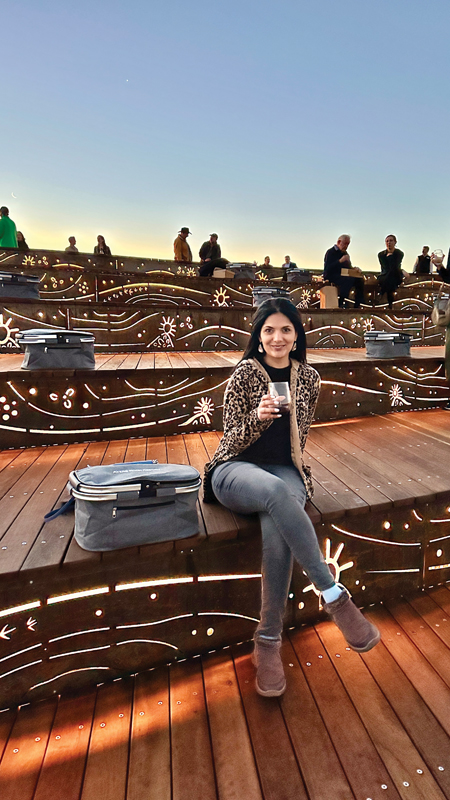
50,000 light spindles spanning seven football fields are part of the world’s first state-of-the-art sound-and-light laser drone show combined with indigenous storytelling.
After a long flight, I was pleased to find comfort foods like chana masala and roti on the breakfast buffet. There are a quarter million people of Indian descent in Sydney, so chances are you will find pretty decent Indian food in Sydney. In Harris Park, aka Little India neighborhood, there’s a concentrated block of restaurants making everything from fresh pani puri and jalebi, to dosa and biryani. I chatted with Udai Rao, the Indian-born general manager of the Four Seasons Hotel, who shared some of his favorite South Asian restaurants around Sydney: Spice Room, Urban Tadka, Safraan, Foreign Exchange, and Lankan Filling Station.
Rao also talked about what he enjoys doing in and around the city: hiking along the coastline from Coogee to Bondi, spending an afternoon at the beach in Manly, and taking day trips to the Blue Mountains and Hunter Valley.
Sydney offers a fun and eclectic range of activities, some of which are:
- If you have a heart for adventure, climb up the Sydney Harbour Bridge, take a scenic seaplane ride over the city, or drop off from a skydive to land on one of the famous beaches.
- There are many free and family-friendly things to do in Sydney as well, including beaches, gardens, coastal walks, galleries, museums, and historic sites.
- Young and old art lovers can let their imagination run free as they explore art pieces and draw their own at the Art Gallery of New South Wales and The Museum of Contemporary Arts.
- And for a unique experience, you can stay at one of the suites at Wildlife Retreat at Taronga Zoo and watch the Australian wildlife right from your bedroom window.
ULURU: The Spiritual Capital
When you see tourism photos of Australia, there’s always an iconic, giant 500-million-year-old red rock surrounded by dusty barren desert landscapes. Uluru-Kata Tjuta National Park is one of the hardest destinations to get to because of its remote location. Many travelers who have limited time in the country don’t get to add it to their itinerary.
I really wanted to go to Uluru because of its spiritual significance. Uluru is an important site for the indigenous people of Australia who inhabited this area for over 60,000 years. The Anangu people, who are the oldest living culture known to man and act as guardians of the park, believe that the landscapes are sacred, living, breathing, ancestral resting places. They still use the numerous caves and fissures to hold sacred ceremonies.
It was a special honor to be at Uluru, to not only be welcomed by its original landowners, but also have an immersive experience through their stories, their music, and their way of life. Starting with the sounds of the didgeridoo, hearing historic facts from an elder on a guided Mala Walk, to seeing glowing orange sunrises and sunsets over the desert landscapes, each moment at Uluru felt magical. I must have taken hundreds of photos of Uluru in its different shades of black, brown, grey, pink, yellow, and red.
I also got to see the recently launched Wintjiri Wiru at Ayers Rock Resort, the world’s first state-of-the-art sound-and-light laser drone show combined with indigenous storytelling. Before dawn, I walked outdoors among 50,000 light spindles spanning seven football fields at the Field of Light exhibit created by artist Bruce Munro. At night, I feasted on a meal prepared using native ingredients under the star- studded Southern Desert sky.
If you go to Uluru, plan to spend at least three days to immerse yourself in the sounds and sights of the land. Besides visiting the attractions, it is also a good place to do yoga, meditation, and hike around the soaring rock formations and sand dunes of Kata Tjuta/ The Olgas.
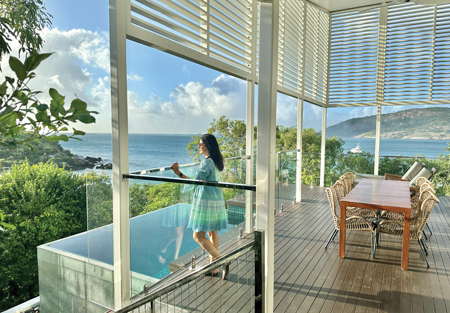
The opulent beach house at Lizard Island Resort, on the Great Barrier Reef, stands secluded within 1,013-hectare National Park. (Photo: Sucheta Rawal)
THE GREAT BARRIER REEF: Nature’s Wonderland
I flew 250 kilometers north from Cannes, a popular tourist city in the state of Queensland, which is the gateway to the Great Barrier Reef. From the fixed-wing flight, I could see fringing reefs with many hues of blue and green around the different islands, many of which are national parks. I couldn’t contain my excitement!
I enjoyed my time at the opulent Lizard Island Resort, the only luxurious accommodation located directly on the reef and standing secluded within a 1,013-hectare National Park. Expansive suites, private beaches, gourmet food, and fine wines were some of the facilities at the resort.
But it was the land and the reef that brought me all the way here. During the day, I went snorkeling right off the beach to see the most colorful and diverse underwater gardens I have seen in my life!
In the afternoon, I chatted with a scientist about preserving the reef at the island’s Research Station, took nature walks over Chinaman’s Ridge with a naturalist to learn about the Dingaal Aboriginal people, and captured pristine views of the bay at sunset.
While there are several day-long boat tours offered from Cairns to snorkel and dive in the inner and outer reefs, the best way to experience the expansive 133,000-square-mile stretch of the largest living structure on Earth is by actually spending a few days on it. You can hire a charter to sail around, dock at one of the public parks, or choose to stay on land at accommodations that range from budget camp-grounds to luxury villas.
CANBERRA: The Political Capital
It took three visits to Australia before I made my way to the landlocked capital. My main reason to come here was to experience the eclectic dining, suburban gems, and 40 or so wineries found in the area. Canberra is often overshadowed by the bigger cities of Sydney and Melbourne nearby.
The fact is that Canberra is the most underrated political capital in the world. With broad streets dotted with flowering gardens and green parks, hazelnut and oak trees, and a cooler climate that supports farming grapes, truffles, dairy, and other agriculture, Canberra is a charming and relatively quiet city. It has a relaxed vibe but still offers many things to do. The locals I met described it as simply “a great place to live.”
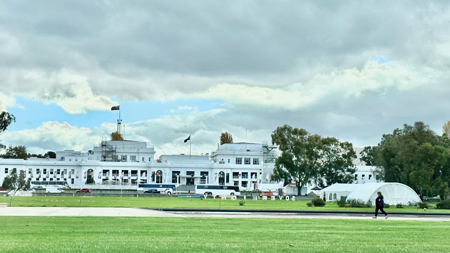
Canberra, the most underrated political capital in the world, but one that the locals describe as simply “a great place to live.” (Photo: Sucheta Rawal)
The main draw for visitors to Canberra is the collection of 23 iconic cultural attractions and museums, each telling a unique perspective of the Australian story from First Nations to contemporary times. You could easily spend days visiting all of them, but if you have to pick a few, I would recommend that you view controversial interactive exhibits at The National Museum of Australia, the largest collection of Australian native flora at the Australian National Botanical Gardens, and a three-acre sculpture garden at the National Gallery of Australia. And for those who prefer to stay away from large crowds, there is a one-person visitor capacity option (no kidding) at the Gallery of Small Things.
You can also take a scenic hot air balloon ride over the picturesque city or hop on a relaxing electric GoBoat at Lake Burley Griffin. If you time your visit well, attend the tulip festival in September or the truffle festival in August. Canberra hosts some of the country’s biggest festivals, sporting matches, and exhibitions.
My personal favorite thing to do is to take a walking tour, called Eat Canberra Food Tour, through the Braddon District. This eclectic area has a variety of locally-run international restaurants, quirky galleries, and affordable boutiques. From Taiwanese soup dumplings to homemade Italian pasta, and Afghan pulaos to Punjabi food trucks, you will find a rare mix of immigrant-run hip establishments that are often otherwise scattered across ethnic neighborhoods.
For a more local flavor, head to the Dairy Road Precinct, a mixed-use former warehouse turned into creative a business site where you can taste Australia’s first carbon-neutral beer at Capital Brewing Co, handmade bean-to-bear chocolates at Jasper+Myrtle, and a simply good cup of infrared roasted coffee at Lonsdale Street Roasters.
TASMANIA: On the Wild Side
No visit to Australia is complete without spotting some of its native wildlife that are otherwise not found anywhere else in the world. While you can see kangaroos and koalas at many parks, zoos, and wildlife centers across the country, the island of Tasmania is one of the best places to get up close to them.
Some of the movie scenes (such as the Oscar-nominated, Lion) depict Tasmania to be a cold, dark, and damp remote island at the last frontier before the Antarctic open waters. But my experience was quite the contrary. Sunny skies, orange-yellow fall foliage, rolling hills, fruit trees, and vineyards in the eastern part of the island, made me feel like I was driving through the Tuscan countryside. The scenic waterfront downtown of Hobart has modern buildings as well as well-preserved Victorian houses and English cottages, some of which have been converted into stylish hotels.
Restaurants in the area serve farm-fresh produce and fresh-caught sustainable seafood and most homes and restaurants seem to have their own backyard gardens. You can find everything from affordable and quality bakeries, ramen, and kebab shops to pre-coursed fine dining restaurants, gin, distilleries, and wineries.
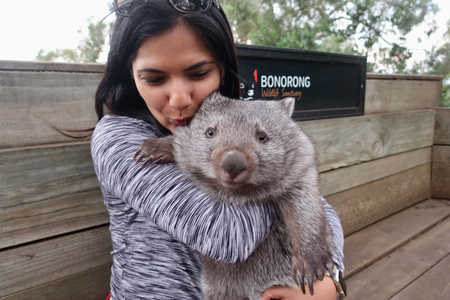
The University of Tasmania has a thriving Indian student body. Besides quality education, students find the safe and welcoming city easily navigable with fairytale-like sceneries just 10 minutes outside the campus.
On the other side of the island, I stayed at a luxurious wood cabin inside Freycinet National Park and overlooking Richardson’s Beach at Freycinet Lodge. Here you can see southern right whales and seals, Bannetts wallabies, pademelons, and echidnas often right from your outdoor jacuzzi tub!
At Maria Island, wild kangaroos and wombats ran free around me as I hiked through the breathtaking scenery and settled for a picnic overlooking seeing bays and rugged cliffs. One of the sociable wombats hurriedly brushed against my jeans which was really special! I also got to see eagles, Cape Barren geese, Tasmanian native hens, parrots, and other endemic bird species.
Tasmania is home to four marsupial species that are not found anywhere else in the world—the Tasmanian devil, eastern quoll, Tasmanian pademelon, and the shy Tasmanian bettong. To see the famous Tasmanian devils known for their loud and disturbing screeching sounds, head to the privately-run Bonorong Wildlife Sanctuary. Depending on who they rescue, you may also encounter wombats, echidna, quolls, native birds, koalas, lizards, snakes, kangaroos, and emus. On a private tour, I was able to cuddle a young wombat, who behaved like a puppy, and feed kangaroos right from my hands. These animals are used to human interactions because of their rescue teams—otherwise, it is not advisable to touch wildlife.
Due to its isolated location—150 miles south of mainland Australia—Tasmania is also one of the best places in the world for star gazing; and you have a good chance to see the great Aurora Australis or the southern lights throughout the year. Make sure to look up into the sky and enjoy nature’s best display over this special country.
~ Written for & published by Khabar Magazine. All rights reserved.